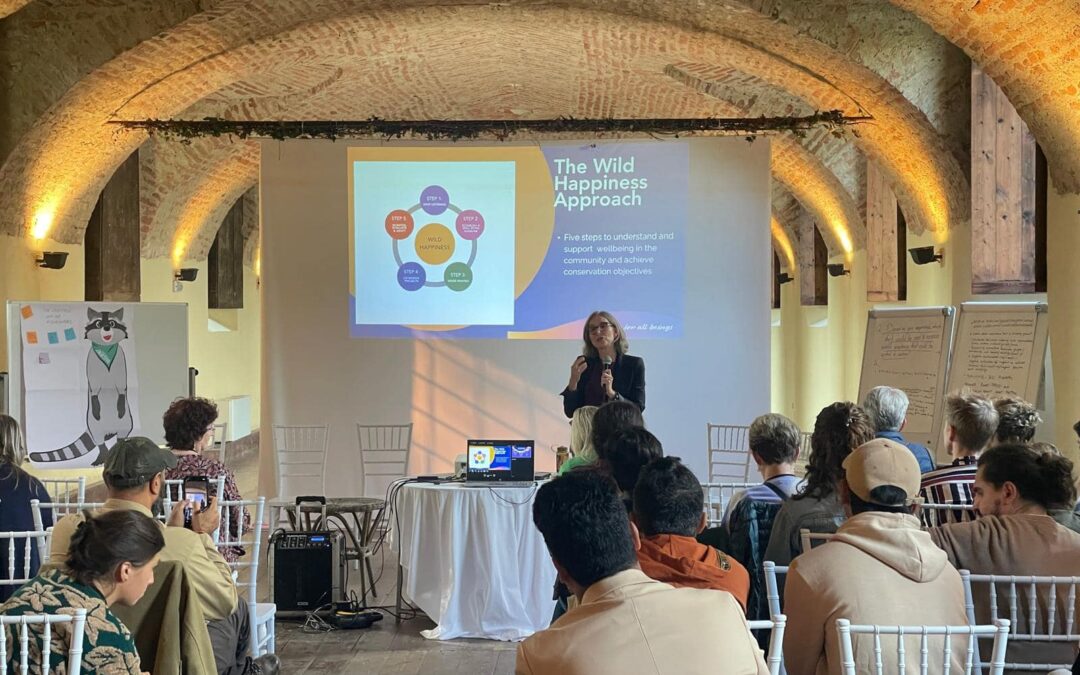In late October, I had the privilege of attending the 2nd International Wildlife Coexistence Network (IWCN) conference, held from October 21-23, 2024, at the breathtaking Workcation Village in Piemonte, Italy. Nestled in a beautifully restored medieval castello, this setting was perfect for deep reflection, connection, and learning. From my window, I had a stunning view—a reminder of nature’s beauty and the profound connections that tie us to the land.
The conference brought together conservation practitioners, researchers, and community leaders from around the world to share their work on human-wildlife coexistence. I had the opportunity to present on our Wild Happiness approach, which integrates community well-being into wildlife conservation. I also contributed a session to the virtual conference on how spiritual and cultural ties to nature serve as powerful motivators for conservation and community resilience.
Sharing the Wild Happiness Approach
My presentation on Wild Happiness highlighted our work to measure and promote well-being in communities involved in conservation efforts. The Wild Happiness Index is a tool we developed to capture both objective and subjective measures of community well-being—factors like social connections, life satisfaction, and spiritual ties to nature. It’s a holistic approach that emphasizes listening to communities, establishing a well-being baseline, and co-creating conservation strategies aligned with local values.
The conference provided a fantastic opportunity to share our work with a broader audience. It was gratifying to connect with so many like-minded conservationists who agree that conservation success must extend beyond ecological metrics to encompass the well-being of communities who coexist with and steward wildlife.
A Setting that Reflected the Spirit of Collaboration
The historic castello, with its winding corridors and centuries-old architecture, created an inspiring backdrop for our discussions. The rooms where we met were steeped in history, fostering an atmosphere that encouraged both reflection and creativity. As I stood to present in one of these beautifully preserved spaces, I couldn’t help but feel a deep sense of connection—not only to the audience but also to the generations of people who had walked those same stone floors.
Beyond the presentations, what I cherished most was the sense of community that emerged among participants. Whether we were discussing coexistence strategies over meals prepared by the village’s charming trattoria or exploring the surrounding countryside, there was a palpable sense of shared purpose. The village itself, lovingly restored by Luca Garrone and his family, truly embodied the conference’s theme of reconnecting as humans through meaningful collaboration.
Looking Ahead
Attending the IWCN conference was a rejuvenating experience, leaving me inspired by the incredible work being done to foster coexistence between humans and wildlife. It reaffirmed my belief in the power of integrating community well-being, cultural values, and spiritual connections into conservation practices. As we continue our work in Rwanda, Laos, and Nepal, I am even more motivated to bring these approaches to life and demonstrate that conservation can indeed be a force for both ecological and human flourishing.
Support Our Vision for Community and Conservation
I invite you to be a part of this journey—together, we can make conservation a force for both ecological and human flourishing. Please consider supporting our year-end fundraising campaign to help make these visions a reality. Every contribution, big or small, brings us closer to a future where well-being and conservation are intrinsically linked. Let’s feel inspired together and build a brighter future for people and wildlife alike.
I’ll be sharing more updates on our projects soon, but for now, I’m grateful for the time spent in Piemonte, surrounded by inspiring colleagues and the timeless beauty of the Italian countryside.
